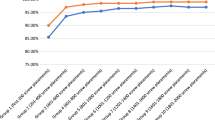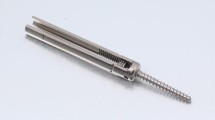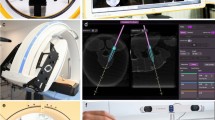Abstract
We performed a randomised controlled study to assess the accuracy of computer-assisted pedicle screw insertion versus conventional screw placement under clinical conditions. One hundred patients scheduled for posterior thoracolumbar or lumbosacral pedicle screw instrumentation were randomised into two groups, either for conventional pedicle screw placement or computer-assisted screw application using an optoelectronic navigation system. From the computer-assisted group, nine patients were excluded: one because of an inadequate preoperative computed tomography study, seven because of problems with the specific instruments or the computer system, and one because of an intraoperative anesthesiological complication. Thus, there were 50 patients in the conventional group and 41 in the computer-assisted group, and the number of screws inserted was 277 and 219, respectively. There was no statistical difference between the groups concerning age, gender, diagnosis, type of operation performed, mean operating time, blood loss, or number of screws inserted. The time taken for screw insertion was significantly longer in the computer-assisted group. Postoperatively, screw positions were assessed by an independent radiologist using a sophisticated CT imaging protocol. The pedicle perforation rate was 13.4% in the conventional group and 4.6% in the computer-assisted group (P = 0.006). Pedicle perforations of more than 4 mm were found in 1.4% (4/277) of the screw insertions in the conventional group, and none in the computer-assisted group. Complications not related to pedicle screws were two L5 nerve root lesions, one end plate fracture, one major intraoperative bleeding and one postoperative death in the conventional group, and one deep infection in the computer-assisted group. In conclusion, pedicular screws were inserted more accurately with image-guided computer navigation than with conventional methods.
Similar content being viewed by others
Author information
Authors and Affiliations
Additional information
Received: 11 October 1999 Revised: 2 February 2000 Accepted: 15 February 2000
Rights and permissions
About this article
Cite this article
Laine, T., Lund, T., Ylikoski, M. et al. Accuracy of pedicle screw insertion with and without computer assistance: a randomised controlled clinical study in 100 consecutive patients. E Spine J 9, 235–240 (2000). https://doi.org/10.1007/s005860000146
Issue Date:
DOI: https://doi.org/10.1007/s005860000146




